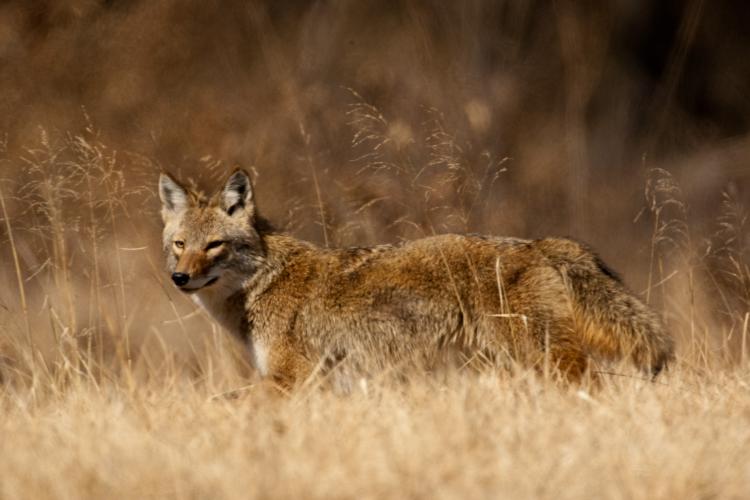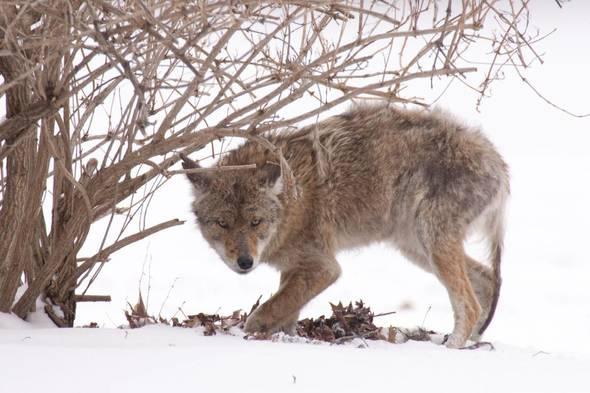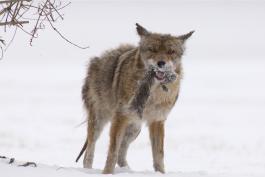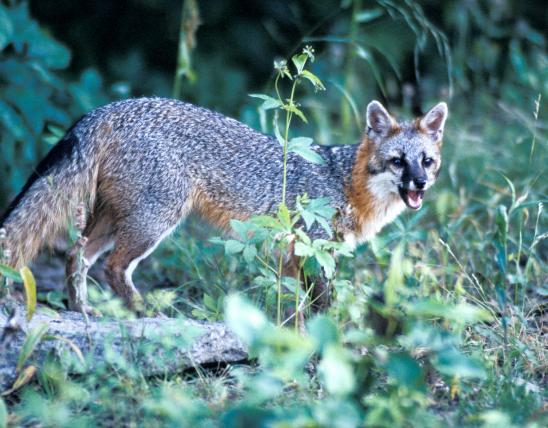
The upperparts of a coyote are light gray or dull yellow, with outer hairs tipped with black. The backs of the ears are reddish and the muzzle yellowish. The top of the tail is colored like the animal’s back, usually with a black tip and whitish below near the base, yellowish toward the tip. The front legs are whitish; the outer sides of the hind legs are reddish, with the inner sides whitish. The throat and belly are white to pale gray. The iris of the eye is tawny. The sexes look very much alike.
Similar species: There is great variety in the bodies of dogs, coyotes, and wolves.
- Coyotes can breed with domestic dogs; their offspring may resemble one or both of the parents.
- The gray wolf is considered extirpated from Missouri, but individuals occasionally wander into Missouri from other states. Missouri hunters have occasionally shot federally endangered wolves, having mistaken them for enormous coyotes. Coyotes seldom exceed 30 pounds in our state, while gray wolves weigh 60–120 pounds.
Total length: 39–54 inches; tail length: 10–16 inches; weight: 18–30 pounds.

Increasing throughout the state; most abundant in grassland habitat in northern and western Missouri.
Habitat and Conservation
Coyotes live in semi-open, brushy country, along timber edges, and in open farmlands, occupying territories ranging from about 9 to nearly 30 square miles.
During most of the year, they merely sleep on the ground in some concealed, protected spot, but in the breeding season they have dens for the young. Dens are usually located in unused fields and are often close to timber. They may be in a bank, under a hollow tree or log, in a rock cavity, or even under a deserted building.
Coyotes have a rich vocabulary of barks, yips, growls, and whimpers. The barks and yips commonly increase in power and pitch and end in a long, flat howl. Howling occurs at any time of the year, but more so during the mating period and less so when there are young. Most people hear coyote howling between sunset and sunrise, but coyotes may also howl during the daytime, especially before a storm or as the result of some stimulus like a siren or whistle. Coyotes may bark alone or together; often, when one starts, others take up the call until it becomes a chorus. Coyote songs can carry for 2 or 3 miles.
Because certain coyotes develop a habit of damaging livestock and poultry, effective control focuses on these particular troublemakers. For nuisance control methods, contact the Department. Additionally, coyotes have been harvested for furs, and hunters and trappers may pursue them during the appropriate furbearer season.
Food
Rabbits and mice make up almost two-thirds of the coyote diet, with other animals and plants (such as persimmons) making up the rest. Coyotes eat carrion as well as prey they kill themselves. While 10 to 20 percent of the diet may represent a loss to humans (livestock and poultry), the rest is neutral or beneficial.
Status
Common and generally increasing throughout the state.
Life Cycle
Coyotes are nocturnal but are also seen in daylight. Coyotes live singly, in male-female pairs, or in family groups. They use complex expressions and postures to communicate. They mate in early spring; litters of usually 5 to 7 pups are typically born in late April or May. Both parents care for the young, which remain with the family as they learn to hunt and behave as adults. Coyotes may live up to 6 to 10 years in the wild and 18 years in captivity.
Control
Human Connections
Coyotes control rodent pests.
Coyote pelts, used for trimming coats and scarves, are durable and attractive and have been increasing in value.
Coyotes are often unjustly blamed for livestock losses caused by free-running dogs.
Ecosystem Connections
Coyotes feed on smaller animals and thus keep their populations in check; they also kill old, injured, sick animals unfit to survive.
As scavengers, they eat carrion and therefore help clean the woods and fields.
Although they can dig their own dens, coyotes frequently remodel the dens of foxes, skunks, woodchucks, or badgers. Thus coyotes often rely on other mammals for habitat. This is similar to the situation where many cavity-nesting birds, such as bluebirds and chickadees, rely on woodpeckers for excavating the original nest holes.
Signs and Tracks
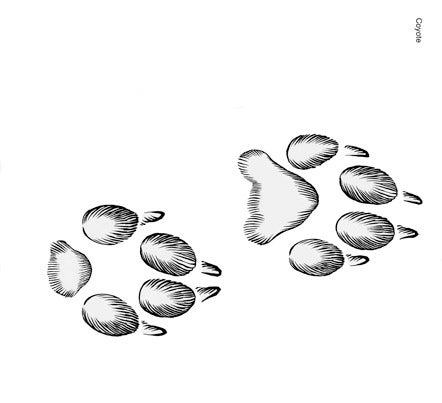
Front track:
- 2½ inches long
- 4 toes.
Hind track:
- 2¼ inches long
- 4 toes.
Other notes:
- Common throughout Missouri.
- Coyote tracks are smaller than most people expect. They are the shape and size of an egg.
- Weight is focused on the middle two toes, which are often slightly pinched inward, with the two middle claw marks very close.
- The middle two claws usually leave marks. The first and fourth claws rarely show, unless in mud, and these can be close enough to the two middle pads as to be hard to see.
- Look for an X shape in the negative space between the pads.
- Stride is 18–22 inches between prints (walking).
- Tracks can be in a more or less straight line.
- Distinguish from similar-sized domestic dogs: coyote tracks overlap (they walk in their own footprints), and the prints are 18–22 inches apart. Medium-sized dogs’ tracks don’t overlap, and they are 6–8 inches apart. Also, domestic dogs tend to meander and not travel in a straight line.
- Scats often contain hair and are often placed in middle of a trail or other prominent place.
- Listen at evening, dawn, dusk for characteristic barks, yelps, and yaps, sometimes in chorus.
